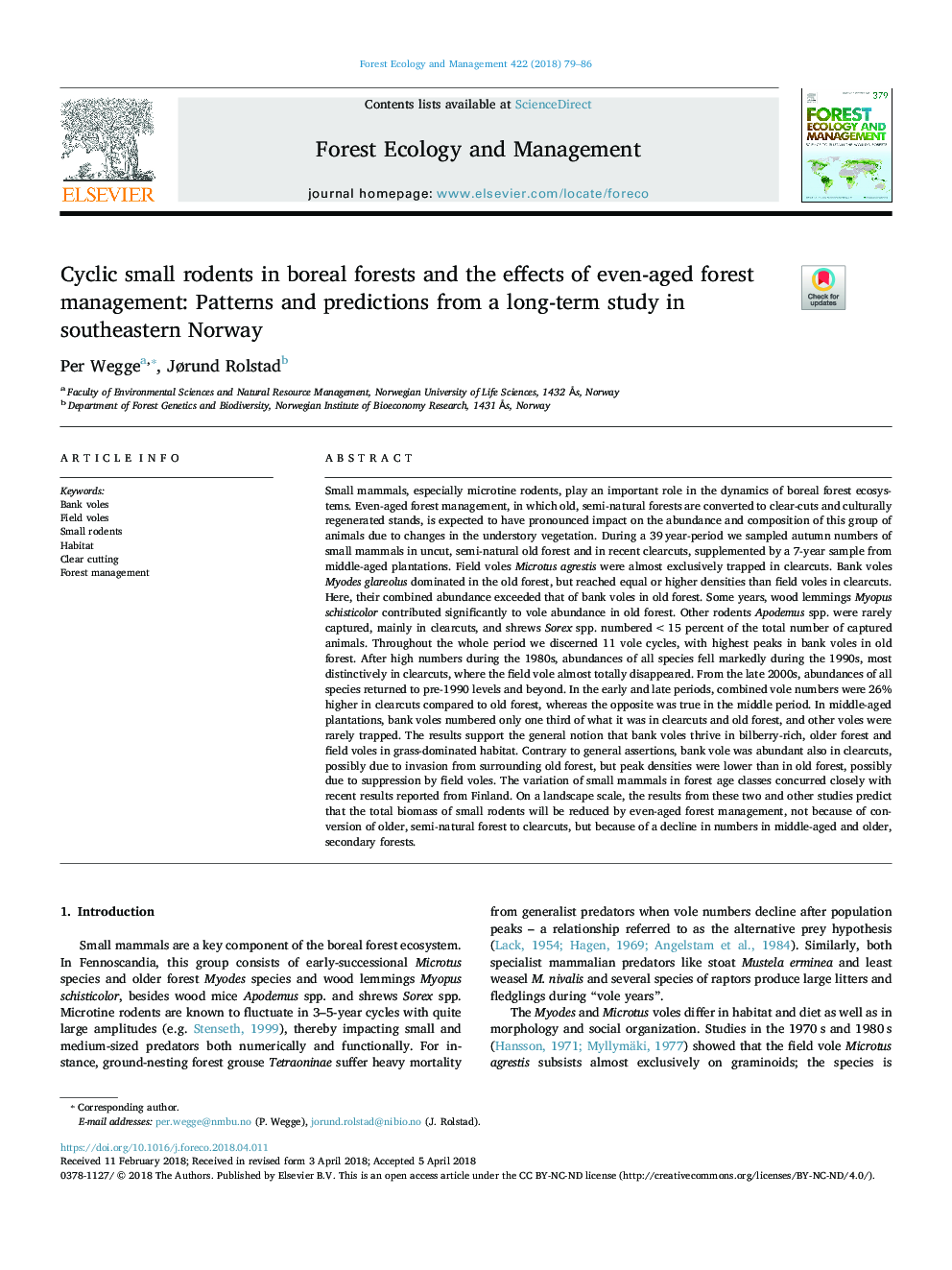| کد مقاله | کد نشریه | سال انتشار | مقاله انگلیسی | نسخه تمام متن |
|---|---|---|---|---|
| 6541653 | 1421338 | 2018 | 8 صفحه PDF | دانلود رایگان |
عنوان انگلیسی مقاله ISI
Cyclic small rodents in boreal forests and the effects of even-aged forest management: Patterns and predictions from a long-term study in southeastern Norway
ترجمه فارسی عنوان
جوندگان کوچک سیکل در جنگل های بکر و اثرات مدیریت جنگل های سالم: الگوهای و پیش بینی های یک مطالعه بلند مدت در جنوب شرقی نروژ
دانلود مقاله + سفارش ترجمه
دانلود مقاله ISI انگلیسی
رایگان برای ایرانیان
کلمات کلیدی
موضوعات مرتبط
علوم زیستی و بیوفناوری
علوم کشاورزی و بیولوژیک
بوم شناسی، تکامل، رفتار و سامانه شناسی
چکیده انگلیسی
Small mammals, especially microtine rodents, play an important role in the dynamics of boreal forest ecosystems. Even-aged forest management, in which old, semi-natural forests are converted to clear-cuts and culturally regenerated stands, is expected to have pronounced impact on the abundance and composition of this group of animals due to changes in the understory vegetation. During a 39â¯year-period we sampled autumn numbers of small mammals in uncut, semi-natural old forest and in recent clearcuts, supplemented by a 7-year sample from middle-aged plantations. Field voles Microtus agrestis were almost exclusively trapped in clearcuts. Bank voles Myodes glareolus dominated in the old forest, but reached equal or higher densities than field voles in clearcuts. Here, their combined abundance exceeded that of bank voles in old forest. Some years, wood lemmings Myopus schisticolor contributed significantly to vole abundance in old forest. Other rodents Apodemus spp. were rarely captured, mainly in clearcuts, and shrews Sorex spp. numbered <15 percent of the total number of captured animals. Throughout the whole period we discerned 11 vole cycles, with highest peaks in bank voles in old forest. After high numbers during the 1980s, abundances of all species fell markedly during the 1990s, most distinctively in clearcuts, where the field vole almost totally disappeared. From the late 2000s, abundances of all species returned to pre-1990 levels and beyond. In the early and late periods, combined vole numbers were 26% higher in clearcuts compared to old forest, whereas the opposite was true in the middle period. In middle-aged plantations, bank voles numbered only one third of what it was in clearcuts and old forest, and other voles were rarely trapped. The results support the general notion that bank voles thrive in bilberry-rich, older forest and field voles in grass-dominated habitat. Contrary to general assertions, bank vole was abundant also in clearcuts, possibly due to invasion from surrounding old forest, but peak densities were lower than in old forest, possibly due to suppression by field voles. The variation of small mammals in forest age classes concurred closely with recent results reported from Finland. On a landscape scale, the results from these two and other studies predict that the total biomass of small rodents will be reduced by even-aged forest management, not because of conversion of older, semi-natural forest to clearcuts, but because of a decline in numbers in middle-aged and older, secondary forests.
ناشر
Database: Elsevier - ScienceDirect (ساینس دایرکت)
Journal: Forest Ecology and Management - Volume 422, 15 August 2018, Pages 79-86
Journal: Forest Ecology and Management - Volume 422, 15 August 2018, Pages 79-86
نویسندگان
Per Wegge, Jørund Rolstad,
